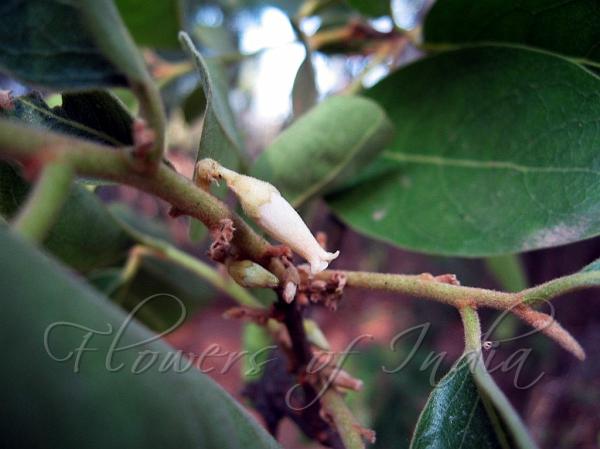|
| Coromandel Ebony |
|

|

| File size | 128158 |
| Original date | 3/29/09 5:04 PM |
| Resolution | 1024 x 768 |
| Flash | Flash did not fire, auto, red-eye reduction |
| Focal length | 5.8mm |
| Exposure time | 1/60s |
| Aperture | 2.6 |
| Focus Distance | |
| Metering Mode | Multi-segment |
| Camera make | Canon |
| Camera model | Canon PowerShot A530 |
| Sensor type | OneChipColorArea |
|
|
|
|
Photo: |
Botanical name: Diospyros melanoxylon Family: Ebenaceae (Ebony family)
Synonyms: Diospyros tupru, Diospyros dubia, Diospyros wightiana
Synonyms: Diospyros tupru, Diospyros dubia, Diospyros wightiana
Coromandel Ebony is a medium-sized tree or shrub up to 25 m, and 1.9 m
girth. The bark is pelican in colour, peeling in rectangular scales, which
is an identifying feature.
The species name melanoxylon comes from the Greek melas
(black) and xylon (wood). The primary root is long, thick and
fleshy at first, afterwards woody, greyish, often swollen in upper part
near ground level. The roots form vertical loops in sucker-generated
plants. Elliptic-oblong leaves can be opposite or alternate, leathery, up to 35 cm long,
velvety on both sides when young, becoming smooth above when fully grown.
Leaves are used for making beedis.
Male flowers are mauve in colour, tetramerous to sextamerous, 1-1.5 cm
long, sessile or nearly sessile in short peduncles, mostly 3-flowered.
Female flowers mauve, mostly extra-axillary or sometimes solitary,
axillary generally 2, opposite each other, larger than the male flowers.
Fruits olive green, ovoid or globose 3-4 cm across; 1-, 2-, 3-, 4-, 5-,
6-, or 8-seeded berries. Pulp yellow, soft and sweet. Seeds compressed,
oblong, shiny, often banded.
| Identification credit: Navendu Pāgé | Photographed in IISc campus, Bangalore & SGNP, Mumbai. |
• Is this flower misidentified? If yes,